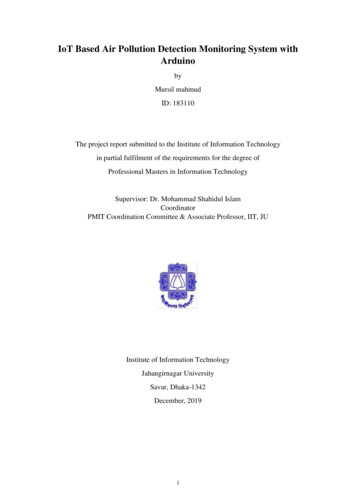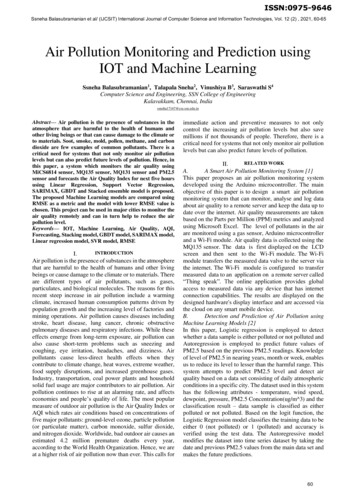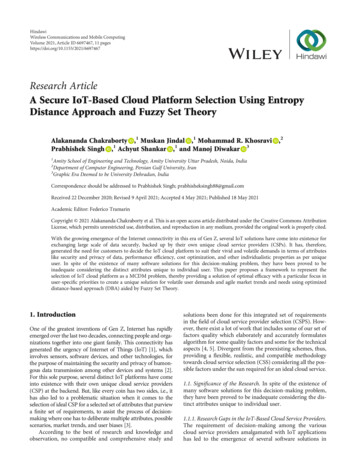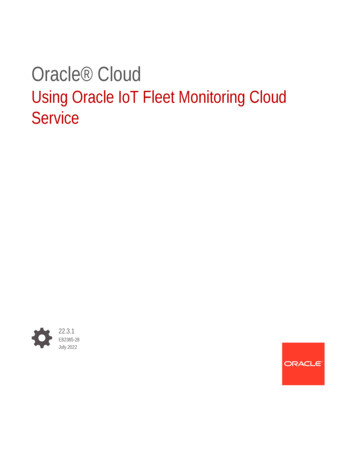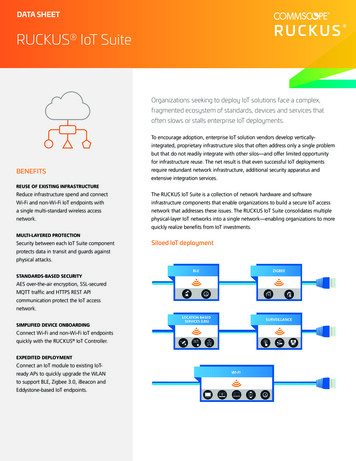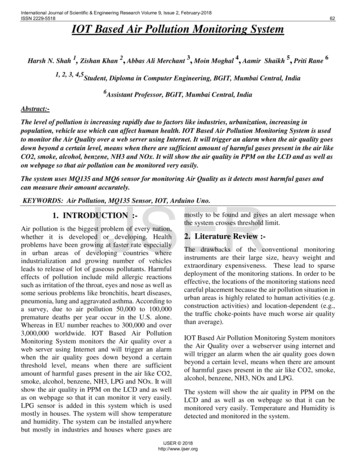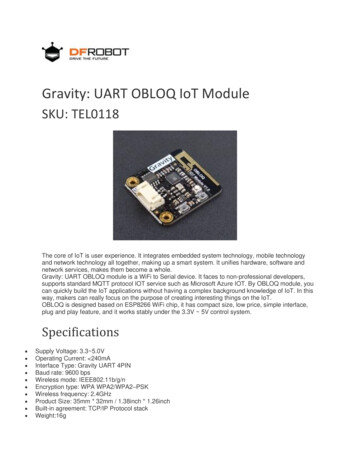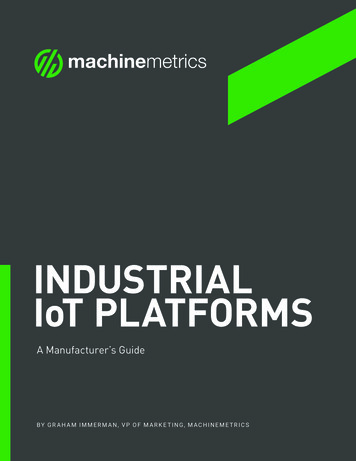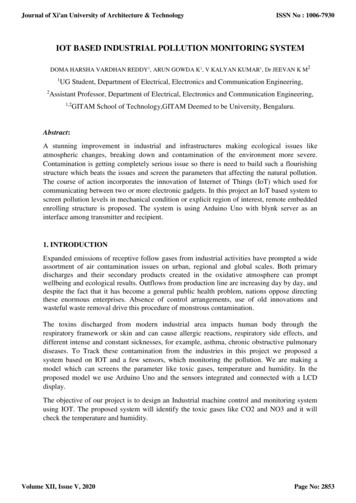
Transcription
Journal of Xi'an University of Architecture & TechnologyISSN No : 1006-7930IOT BASED INDUSTRIAL POLLUTION MONITORING SYSTEMDOMA HARSHA VARDHAN REDDY1, ARUN GOWDA K1, V KALYAN KUMAR1, Dr JEEVAN K M212UG Student, Department of Electrical, Electronics and Communication Engineering,Assistant Professor, Department of Electrical, Electronics and Communication Engineering,1,2GITAM School of Technology,GITAM Deemed to be University, Bengaluru.Abstract:A stunning improvement in industrial and infrastructures making ecological issues likeatmospheric changes, breaking down and contamination of the environment more severe.Contamination is getting completely serious issue so there is need to build such a flourishingstructure which beats the issues and screen the parameters that affecting the natural pollution.The course of action incorporates the innovation of Internet of Things (IoT) which used forcommunicating between two or more electronic gadgets. In this project an IoT based system toscreen pollution levels in mechanical condition or explicit region of interest, remote embeddedenrolling structure is proposed. The system is using Arduino Uno with blynk server as aninterface among transmitter and recipient.1. INTRODUCTIONExpanded emissions of receptive follow gases from industrial activities have prompted a wideassortment of air contamination issues on urban, regional and global scales. Both primarydischarges and their secondary products created in the oxidative atmosphere can promptwellbeing and ecological results. Outflows from production line are increasing day by day, anddespite the fact that it has become a general public health problem, nations oppose directingthese enormous enterprises. Absence of control arrangements, use of old innovations andwasteful waste removal drive this procedure of monstrous contamination.The toxins discharged from modern industrial area impacts human body through therespiratory framework or skin and can cause allergic reactions, respiratory side effects, anddifferent intense and constant sicknesses, for example, asthma, chronic obstructive pulmonarydiseases. To Track these contamination from the industries in this project we proposed asystem based on IOT and a few sensors, which monitoring the pollution. We are making amodel which can screens the parameter like toxic gases, temperature and humidity. In theproposed model we use Arduino Uno and the sensors integrated and connected with a LCDdisplay.The objective of our project is to design an Industrial machine control and monitoring systemusing IOT. The proposed system will identify the toxic gases like CO2 and NO3 and it willcheck the temperature and humidity.Volume XII, Issue V, 2020Page No: 2853
Journal of Xi'an University of Architecture & TechnologyISSN No : 1006-79302. LITERATURE REVIEWThere are so many works being carried out by many researchers in the field of air pollutionmonitoring based on IoT. This chapter illustrates some of the important and recently publishedpapers in the field of IoT based air pollution monitoring system.Chen Xiaojun published a paper “IoT- Based Air Pollution Monitoring and ForecastingSystem” in the year 2015, which describing an IoT based system for air pollution monitoringand forecasting. A low cost air pollution monitoring system was proposed by Khaled BashirShaban et, al. in their paper entitled “Urban Air Pollution Monitoring System With ForecastingModels”. The system was capable of receiving, storing and preprocessing the data. It is capableof converting the data into useful information.“Smart Industry Pollution monitoring and controlling using LabVIEW based IoT” wasproposed by Kunja Bihari Swain et.al. in the year 2017. This paper introduces a Lab viewbased online pollution monitoring of industries for the control over pollution caused byuntreated disposal of wasteGagan Parmar proposed “An IoT Based Low Cost Air Pollution Monitoring System”in the year2017.This system measures concentrations of gases such as CO, CO2, SO2 and NO2usingsemiconductor sensors. The sensors will gather the data of various environmental parametersand provide it to raspberrypi which act as a base station. Realization of data gathered bysensors is displayed on Raspberry pi 3 based Webserver. A MEAN stack is developed todisplay data over website. The fundamental aspect of proposed work is to provide lowcostinfrastructure to enable the data collection and dissemination to all stakeholders.S.Muthukumar proposed “IoT based air pollution monitoring and control system”in the year2018.There work considers pollution due to automobiles and provides a real time solutionwhich notjust monitors pollution levels but also take into consideration control measures forreducing traffic in highly polluted areas .The solution is provided by a sensor based hardwaremodulewhich can be placed along roads. These modules can be placed on lamp posts and theytransfer information about air quality wirelessly to remote server. This information can be usedfortraffic control. The proposed system also provides information about air quality through amobile application which enables commuters to take up routes where air quality is good.Harsh Gupta proposed “An IoT Based Air Pollution Monitoring Systemfor Smart Cities”In theyear 2019.This system propose and develop an IoT based Air Quality Monitoring System forSmart Cities. The real-time data of the air quality is accessed through the smart devices andanalyzed to measure the impact on city dwellers. The smart devices are capable of measuringthe Temperature, Humidity, Carbon Monoxide, LPG, Smoke and other hazardous particulatematters like PM2.5 and PM10 levels in the atmosphere. The gathered data is accessibleglobally through an Android Application.Volume XII, Issue V, 2020Page No: 2854
Journal of Xi'an University of Architecture & TechnologyISSN No : 1006-79303. METHODOLOGYfig.1 Work flow chart3.3 EXISTING SYSTEMThe calculation of industrial pollutant parameters by using components like raspberry pi andmy sql database for transportation of the data.An IoT-based industrial air quality monitoringplatform, consisting of an air quality-sensing device called “Smart-Air” and a web server, isinterfaced.The device was designed to measure a concentration of aerosol, VOC, CO, CO2, andtemperature-humidity to monitor the air quality.The above mentioned system consists of largeamount of expensive sensors and we build a low cost device to find accurate parameters ofpollutants around industrys .Volume XII, Issue V, 2020Page No: 2855
Journal of Xi'an University of Architecture & TechnologyISSN No : 1006-79303.4 PROPOSED SYSTEMNowadays different types of industries are mushrooming all over the world. These industriesare polluting our environment with toxic gases and other hazardous objects. In this contest, weproposed an industrial pollution monitoring system which uses an Arduino board along withsensors which senses some kind of toxic gases, temperature, humidity ect. We are using DHT11 sensor for sensing temperature and humidity, MQ-5 sensor for sensing concentration ofcarbon monoxide and MQ-135 for sensing smoke which in turn identify the fire accident.Arduino board collects the output from each sensor and updates it into the online database byblynk server.This data is analyzed and measured against a predetermined threshold value. If the calculatedvalues are greater than threshold value the data is recorded and alert is send to the personconcerned. It is an IoT based system. Fig. 2 depicts the block diagram of proposed system.4. PROPOSED STRUCTURE4.1 BLOCK DIAGRAM:fig.2 Block diagram4.2 TRANSMITTER SECTIONIn the transmitter area, to screen the parameters, we mount sensors like MQ-135, MQ-5 andDHT11 to detect these parameters. The information from these sensors coordinated withArduino UNO board works at 5V. To enable the information to go over an Internet we areassociating blynk server. We use a buzzer if the value of MQ-5 sensor raises above thethreshold value. The LCD Display is used to display the values of the different sensors.4.3 RECEIVER SECTIONIn the beneficiary segment, hotspot is to be actuated on client's cell phone or desktop to get tointernet browser. An IP address is to be entered in internet browser to get to related page whichwill demonstrate the observing outcomes on client's cell phone screen. From the above model,process is separated in 5 layers.Volume XII, Issue V, 2020Page No: 2856
Journal of Xi'an University of Architecture & TechnologyISSN No : 1006-7930The ecological parameters which are to be estimated are presented in layer 1. Investigation ofthe qualities and highlights of sensor gadgets is in layer 2. In layer 3, there is basic leadershipon detecting, estimating and fixing the edge esteem, periodicity of affectability, timing, spaceof sensors. Sensor information obtaining is done in layer 4.and more, layer 5 as encompassinginsight condition. The sensors can be worked by the microcontroller to recover the informationfrom them and it forms the investigation with the sensor information and updates it to theInternet through Wi-Fi module associated with it. Client can screen the parameters on their cellphones just as desktop or workstation.4.4 EXPERIMENTAL SETUPfig.4 The industrial pollution monitoring system5.RESULTAn IoT based industrial pollution monitoring sytem is developed and tested. The values of thepollutant gases like carbon monoxide, nitrate (NO3) and carbon dioxide released from differentindustries. We also measured temperature and the humidity of the industrial area. The datacorresponds to the pollutants gases are identified and if the values are above the thresholdvalues the intimation is send to the mobile phone, which is initialized in the program. It istested successfully. The buzzer also activated if the pollutant gases are above the thresholdvalue. The parameter values are displayed in the LCD display. Fig. 3 shows the industrialpollution monitoring system we developed.Volume XII, Issue V, 2020Page No: 2857
Journal of Xi'an University of Architecture & TechnologyparametersgitamTemperature33 CHumidity44%Toxic gases(CO2)90ppmPoisoning gases(CO)70ppmISSN No : 1006-7930fig.5 parameters of GitamThe parameters which have been calculated in Gitam indoor as a testing of the device arerepresented in fig.5.fig.6 results in LCDThe output parameters of LCD is shown in fig6.6. ADVANTAGESReducing the respiratory problems due to industrial activities and to monitor the level of airpollution around industrial area.The main focus in finding solutions to the increasing problemof harmful gasses amounting from industrial practices in the country have been resolved .Thisallows authorities to monitor air pollution in different areas and act against it .Based upon thedata collected control measures can be devised for protection of environment and health of allliving organisms. Air quality data helps us understand the mortality rate of any location due toair pollution. Industrial pollution monitoring would assist in determining if air pollution controlprogrammes devised in a locality are working efficiently or not. Protects and alerts the workersin the mining area or petroleum industries or thermal power plant by alerting them of thedanger by assessing the pollutant gasses.Volume XII, Issue V, 2020Page No: 2858
Journal of Xi'an University of Architecture & TechnologyISSN No : 1006-79307. CONCLUSIONAn IoT based stem for industrial pollution monitoring system is successfully developed andtested. We measured the presence of pollutant gases in and around different industrial areas.We also measured the temperature and humidity in that place. The messaging system andbuzzer alert worked successfully.REFERENCES[1]. Chen Xiaojun, Liu Xianpeng, Xu Peng, “IOT-Based Air Pollution Monitoring andForecasting System”, 2015 International Conference onComputer and ComputationalScience (ICCCS).[2]. Dongyun Wang, Chenglong Jiang, Yongping Dan, “Design of air quality monitoringsystem based on Internet of things” 10th International Conference on Software,Knowledge, Information Management & Applications (SKIMA), 2016.[3]. Khaled Bashir Shaban, Abdullah Kadri, Eman Rezk, “Urban Air Pollution MonitoringSystem With Forecasting Models” IEEE Sensors Journal, Vol. 16, No.8,April 15,2016.[4]. Bhavika Bathiya, Sanjay Srivastava, Biswajit Mishra, “Air pollution Monitoring UsingWireless Sensor” 2016 IEEE International WIE Conference on Electrical and ComputerEngineering (WIECON-ECE) 19-21 December 2016, AISSMS, Pune, India.[5]. Kunja Bihari Swain,G. Santamanyu,Amiya Ranjan Senapati;“Smart Industry PollutionMonitoring and Controlling using LabVIEW based IoT”2017IEEE 3rd InternationalConference on Sensing, Signal Processing and Security (ICSSS).[6]. Gagan Parmar,Sagar Lakhani, Manju K. Chattopadhyay;“An IoT Based Low Cost AirPollution Monitoring System”IEEE Proceeding International conference on RecentInnovations is Signal Processing and Embedded Systems (RISE-2017) 27-29October,2017.[7]. S.Muthukumar,W.Sherine Mary,Jayanthi.S,Kiruthiga.R,Mahalakshmi.M;“IoT based airpollution monitoring and control system”Proceedings of the International Conferenceon Inventive Research in Computing Applications (ICIRCA 2018) IEEE XploreCompliant Part Number:CFP18N67-ART; ISBN:978-1-5386-2456-2.[8]. Harsh Gupta,Dhananjay Bhardwaj,Himanshu Agrawal,Vinay Anand Tikkiwal,ArunKumar;“An IoT Based Air Pollution Monitoring System for Smart Cities”ICSETS2019.[9]. Nihal Kularatna, B.H. Sudantha, “An Environmental Air Pollution Monitoring SystemsBased on the 1451 Standard for Low Cost Requirements” IEEE Sensors Journal, Vol.8,No.4, April 2008.Volume XII, Issue V, 2020Page No: 2859
Journal of Xi'an University of Architecture & TechnologyISSN No : 1006-7930[10].J.-Y. Kim, C.-H. Chu, and S.-M. Shin, “ISSAQ: An Integrated Sensing Systemsfor Real-Time Indoor Air Quality Monitoring,”Sensors Journal, IEEE, vol. 14, no. 12,pp. 4230–4244, Dec. 2014.[11].O. Postolache, J. Pereira, and P. Girao, “Smart sensors network for air qualitymonitoring applications,” Instrumentation and Measurement, IEEE Transactions on,vol.58, no. 9, pp. 3253–3262, Sept 2009.[12].J. A. Stankovic, “Research directions for the internet of things,” IEEE InternetThings J., vol. 1, no. 1, pp. 3–9, 2014.[13].S. Kelly, N. Suryadevara, and S. Mukhopadhyay, “Towards the Implementationof IoT for Environmental Condition Monitoring in Homes,” Sensors Journal, IEEE, vol.13, no. 10, pp. 3846–3853,Oct. 2013.[14].R. Bhadoriya, M. K. Chattopadhyay and P. W. Dandekar, "Low cost IoT forlaboratory environment," 2016 Symposium on Colossal Data Analysis and Networking(CDAN), Indore, 2016,pp. 1-4.[15].J. J. Caubel, T. E. Cados, and T. W. Kirchstetter, “A New Black Carbon Sensorfor Dense Air Quality Monitoring Networks,” Sensors, vol. 18, no. 3, p. 738, 2018.Volume XII, Issue V, 2020Page No: 2860
System" in the year 2015, which describing an IoT based system for air pollution monitoring and forecasting. A low cost air pollution monitoring system was proposed by Khaled Bashir Shaban et, al. in their paper entitled "Urban Air Pollution Monitoring System With Forecasting Models". The system was capable of receiving, storing and .
